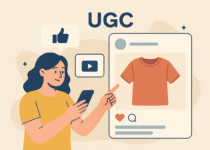What marketing can learn from Cannes Lions 2025
3 Big takeaways that matter for 2026: Unshittification
Riding the ‘being human’ wave from 2025, we’re still moving forward. It’s just more integrated, less showy.
For 2026, we’re adding the ‘unshittification’. We’re done. We’re fed up with the AI-generated and automated fakeness. We’re numbed by the algorithm fixing that results in more of the same content. We’re tired of the fast-paced microtrends.
We want personal attention, human connection, and meaning. And, we expect brands to go deep on tech but make it very simple.
For marketing and content strategists, Cannes Lions isn’t just inspiration; it’s the new standard. And the bar is not just raised, but redefined.
What you need to know for your brand, marketing and content in 2026:
- Social tiredness: brands need to behave like creators
- Brand building is (again) the most important: long-term consistency
- In the age of technology, it’s creativity and trust that set you apart
1. Social tiredness: brands need to behave like creators
There’s a huge wearout of being social on social. This is what you need to know:
- Lower engagement. We’re tired of commenting, liking, and sharing. We’re not tired of (brand) content, though. Actually, 71% of TikTokers want brands to be on TikTok, and on Instagram, only 15% of the feed is from friends.
- We view the content in a glance of 1.3 seconds. If we like what we see, we spend a bit more time, but after a few seconds, we’re off to the next, without leaving a visible sign of engagement. However, we do trigger the algorithm to show more of this type of content.
- Algorithm fixing. We get bored really fast. The algorithm feeds us more of the same, and we create content that fits what the algorithm wants to push. Within a short time, we hit overload, bored with the format, tired of the trend, and just like that, we move on to the next content micro trend.
- Social channels become publication channels. Nowadays, social is like watching TV with a chat function. TikTok (and Instagram) are about consuming content, it’s about entertainment, it’s not about connecting with your friends and family. And it’s about content that’s really entertaining, and that teaches you something.
What to do: behave like a creator
Brands need to behave like creators, producing content that adds value. Because people want to be entertained, inspired, and informed, they don’t want ads.
There’s a huge difference between creating an ad and creating content for entertainment. As soon as content starts to smell like commerce, people tune out. Nobody wants to be marketed to. And it’s good to realize that 61% of consumers trust creator content, while 38% trust brand content. (Cannes Lions). So if you behave more like a creator, you’ll also gain more trust.
Example: ‘Vaseline Verified’
Vaseline becomes the voice of reason in a world of viral beauty hacks. They add value by verifying and debunking myths in UGC, making the brand a cheeky authority. (case description)
2. Brand building is (again) the most important: long-term consistency
As said, people want content, not ads. That means for brands, a shift from performance focus to brand building. To build trust and credibility. And that pays off, seeing the Cannes Lions this year:
- ‘Dove Real Beauty,’ how a soap brand created a global self-esteem movement for 20 years
- ‘L’Oreal’, the final copy of Ilon Specht was a feminist breakthrough (1971)
What to do: 60–40 rule
The 60–40 rule still holds: balance your budget with 60% for brand building and 40% for performance marketing.
In this brand building, it’s about consistency. Showing up and doing that frequently, and recognizably. Not a short and fast campaign, but year after year.
It’s also about the long-term trust and reciprocation, not immediately wanting to close a sale, but to really help your customer, even if that means they don’t buy directly from you. After all, only 5% of (B2B) customers are ready to buy, and the best metric of success is retention: customers who repeat the purchase.
B2B is finally catching up
The new kid on the block: B2B. It looks like B2B is becoming sexy and the new playground for marketers. And I get it. Where B2B was still rather traditional, now it’s time to apply lessons from B2C to B2B.
Ultimately, we communicate with humans, and in B2B, this interaction is even more personal than in B2C, as the buying journey is longer, more intense, and more personalized.
Don’t think that because you’re in B2B, the basic rules of attraction suddenly don’t apply.
→ B2B Cannes Lions winner shows how it’s done: GoDaddy AI software to launch your website and socials
Example: ‘Dove Real Beauty,’ how a soap brand created a global self-esteem movement for 20 years
It began in 2004 with a bold insight: only 2% of women considered themselves beautiful. Dove challenged the industry’s narrow ideals by celebrating confidence over perfection, sparking one of the first viral marketing movements.
Reaching millions of young people. Dove didn’t stop at ads; it backed real change, supporting laws like the Crown Act against hair discrimination, and fighting toxic beauty standards on social media. (case description)
3. In the age of technology, it’s creativity and trust that set you apart
We’ve moved past the novelty of AI hype. We still use it, of course, but AI is no longer a differentiator. It’s a commodity. Now, creating content has never been easier, but the result often feels like more of the same. And that’s not how you build your brand.
What to do: ‘involve the crazy ones’
It’s not the tech that sets you apart, it’s the creativity behind it. The curious, messy, and dirty mind that makes unexpected connections and challenges the status quo and how things have always been done.
What really matters is the human marketer who’s guiding the technology to create content that makes your brand stand out.
With the side note that being different and innovative isn’t always about technology; it’s also about looking at things differently.
Example: Penny locks in price stability in times of inflation
During a period of steep inflation, Penny offered long-term price stability on everyday essentials by locking prices permanently by printing them directly on the packaging. ‘If you print it on the package, you can’t change it.’
This is creative thinking and innovation by design, not by technology. (case description)
Now it’s up to you to sharpen your communications, to get reach and stay relevant. If you don’t, your competitor will.
Do you want to know more? Check uit the full 11 min read article
And subscribe to my LinkedIn newsletter.
Two-click subscribe, and one-click unsubscribe if it’s not for you. Easy does it.


